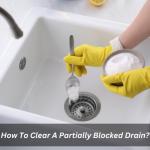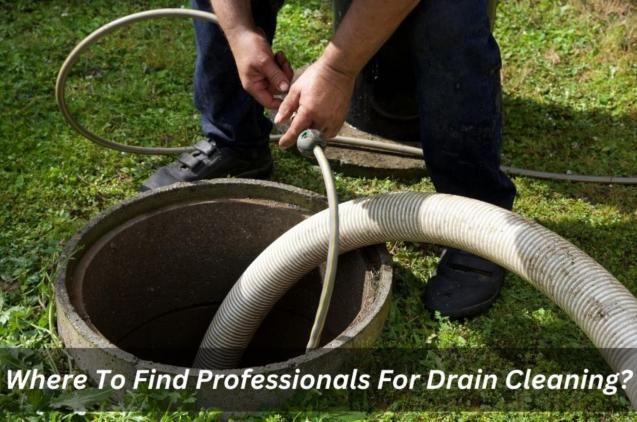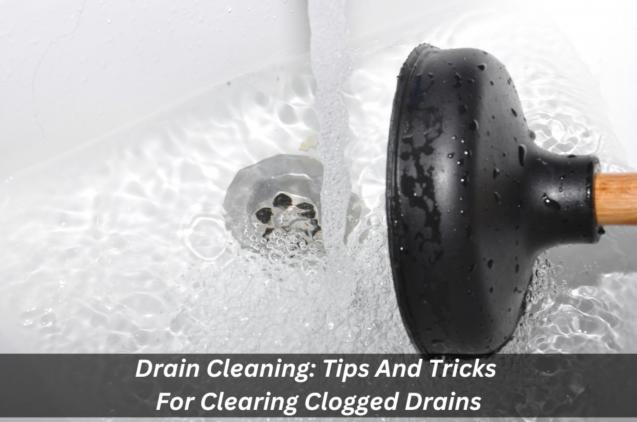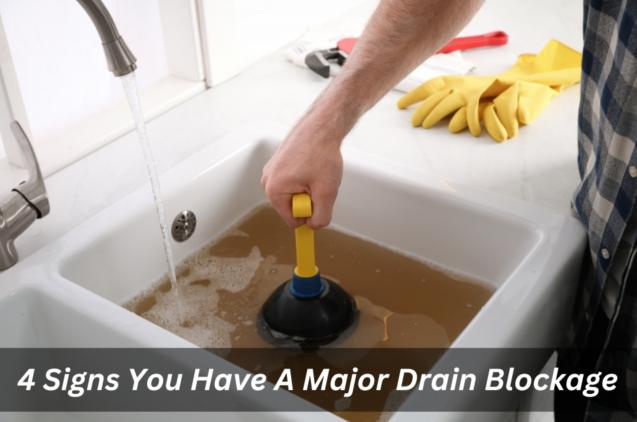
How To Clear A Partially Blocked Drain?
By Sydney Blocked Drain Service|March 16, 2023
What Is A Partially Blocked Drain?
A partially blocked drain is a common problem that can be caused by many different things. Depending on the cause of the blockage, a partial blockage may not require major blocked drain repairs or replacement of the entire pipe system. A partially blocked drain can be identified by gurgling sounds coming from drains, slow-flushing blocked toilets, and water backing up in your kitchen sink. If you're experiencing any of these signs of a blocked drain, it's best to call in a professional plumber to assess the situation and take appropriate action.
In most cases, a plumber will use a snake or auger to remove the blockage from the pipe. This is usually enough to clear minor clogs such as hair or soap scum buildup. If tree roots are causing the issue, they may need to be cleared with professional equipment such as a CCTV drain camera or pipe relining technology. In some cases, caustic cleaners found at hardware stores may also help break down stubborn clogs.
If all else fails, your plumber may recommend replacing part of the plumbing system if it’s been damaged due to blocked drains or if there’s an extensive blockage such as a blocked sewer drain. The only way to ensure full clearance is by having a qualified plumber assess your pipes and use specialised equipment such as hot water jetting or high-pressure cleaning to get rid of any remaining debris and restore your drainage system back to normal!
Causes Of A Partially Blocked Drain
Blocked drains are a common problem in homes, and there are many potential causes of a partially blocked drain. Common culprits include hair and soap scum build-up, tree roots infiltrating the pipes, or objects getting stuck in the pipes. In addition to this, more serious issues such as pipe damage or an extensive blockage can also be responsible for a partial blockage.
In order to identify the cause of your blocked drain, it's crucial to call in an experienced plumber who will use specialised equipment such as CCTV drain cameras or augers to locate any clogs and take appropriate action. Depending on the severity of the issue, they may suggest using caustic cleaners from hardware stores, hot water jetting or high-pressure cleaning to clear out any debris. In some cases, the replacement of part of the plumbing system may be necessary if it is damaged due to a blocked drain.
It's important to remember that trying to fix a partially blocked drain yourself without calling a professional can do more harm than good - so make sure you get help from an expert if you're facing this issue!
Using Hot Water And White Vinegar To Clear The Drain
Using hot water and white vinegar to clear the drain is a great DIY solution for partially blocked drains. All you need to do is mix equal parts of white vinegar and hot water, pour it down the drain and let it sit for around 15 minutes. After that, flush your sink with plenty of hot water to wash away any debris or build-up that may have clogged up your drain.
This solution is an effective way to unclog a partially blocked drain as it helps to break down and remove any soap scum, grease, hair, or food particles that may be causing a blockage. It's non-toxic and safe for use in most household plumbing systems, making it an ideal choice for DIYers looking for an easy fix.
If this doesn't work, however, it's time to call in a professional plumber who will be able to identify the cause of the blockage and take appropriate action.
Unclog With Baking Soda, Vinegar, and Boiling Water
If you’re looking for an easy and effective way to unclog your partially blocked drain, try using baking soda, vinegar, and boiling water. All you need to do is mix a part of baking soda with an equivalent part of white vinegar into a bowl. Pour it down the drain boiling water.
Give it some time - around 10 minutes - before flushing your sink with hot water. This combination works wonders as the baking soda helps to break down any build-up while the vinegar acts as a powerful drain-cleaning agent that can help dissolve soap scum or grease.
It’s also non-toxic, so it won’t harm your plumbing system in any way. If this doesn’t work, however, it’s best to call in a professional plumber so they can identify and fix the issue for you.
Use a Wire Coat Hanger to Remove Clogs
If you’ve ever had a partially blocked drain and don’t want to call in a plumber, then one of the best tools available is a wire coat hanger. It’s an inexpensive and easy way to remove clogs from your sink or shower drain. Before you get started, make sure that the hanger is straightened out as much as possible so it can fit down into the pipe. Once it’s ready, carefully insert it into the drain opening and work it back and forth until you reach the clog. If you feel like there’s something blocking further up the pipe, try using some wiggling motions with the hanger to loosen it up and push it through. Once the object has been cleared out of the way, flush your sink with hot water to ensure that everything is flowing freely again. With a little bit of time and effort, this simple technique can help save you money on costly plumbing services.
Utilise the Plunger or a Toilet Snake to Clear The Drain
The plunger is an inexpensive and effective way to clear a partially blocked drain. It works by using suction to dislodge the blockage. To use the plunger, make sure that it is completely submerged in water before you start plunging. Once the plunger is firmly attached to the drain opening, start pushing down rapidly and vigorously for several minutes. This should create enough pressure to loosen any clogs in your plumbing system. If necessary, repeat this process several times until the blockage has been cleared away and you see water draining freely.
If plunging doesn't do the trick, then you may need to use a toilet plumber's snake or auger. This tool can be purchased from most hardware stores and can help reach further down into your pipes to break up stubborn clogs. Before using it, make sure that it is inserted as far as possible into your drainpipe before turning on its motor or crank handle. Doing so will help ensure that you are able to unclog even the deepest blockages without damaging your plumbing system.
Professional Assistance For Severe Blockages
If your blockage is too severe for a plunger or toilet snake to clear, then it may be time to call in a professional plumber. Professional plumbers have the tools and expertise needed to not only unclog your drain but also inspect and repair any underlying problems that may have caused the blockage in the first place. This could include checking for tree roots that have invaded your sewer pipe, using a CCTV drain camera to identify cracks or damage in your pipes, and even performing pipe relining if necessary. In addition, they can also recommend preventative measures you can take going forward to reduce the chance of future drain blockages occurring. So don't wait until it's too late - contact a qualified blocked drain plumber today if you're having problems with blocked drains in Sydney!
Conclusion
No matter what your blocked drain is caused by, the key to resolving it quickly and safely is to contact a qualified plumber right away. Your local plumbing expert has the tools and expertise needed to not only unclog your drain but also inspect and repair any underlying issues that may have caused the blockage in the first place. Not to mention, they can also recommend preventative measures you can take going forward to reduce the chance of future blockages occurring. So don't wait until it's too late - contact a professional plumber today if you're having problems with blocked drains in Sydney!
A partially blocked drain is a common problem that can be caused by many different things. Depending on the cause of the blockage, a partial blockage may not require major blocked drain repairs or replacement of the entire pipe system. A partially blocked drain can be identified by gurgling sounds coming from drains, slow-flushing blocked toilets, and water backing up in your kitchen sink. If you're experiencing any of these signs of a blocked drain, it's best to call in a professional plumber to assess the situation and take appropriate action.
In most cases, a plumber will use a snake or auger to remove the blockage from the pipe. This is usually enough to clear minor clogs such as hair or soap scum buildup. If tree roots are causing the issue, they may need to be cleared with professional equipment such as a CCTV drain camera or pipe relining technology. In some cases, caustic cleaners found at hardware stores may also help break down stubborn clogs.
If all else fails, your plumber may recommend replacing part of the plumbing system if it’s been damaged due to blocked drains or if there’s an extensive blockage such as a blocked sewer drain. The only way to ensure full clearance is by having a qualified plumber assess your pipes and use specialised equipment such as hot water jetting or high-pressure cleaning to get rid of any remaining debris and restore your drainage system back to normal!
Causes Of A Partially Blocked Drain
Blocked drains are a common problem in homes, and there are many potential causes of a partially blocked drain. Common culprits include hair and soap scum build-up, tree roots infiltrating the pipes, or objects getting stuck in the pipes. In addition to this, more serious issues such as pipe damage or an extensive blockage can also be responsible for a partial blockage.
In order to identify the cause of your blocked drain, it's crucial to call in an experienced plumber who will use specialised equipment such as CCTV drain cameras or augers to locate any clogs and take appropriate action. Depending on the severity of the issue, they may suggest using caustic cleaners from hardware stores, hot water jetting or high-pressure cleaning to clear out any debris. In some cases, the replacement of part of the plumbing system may be necessary if it is damaged due to a blocked drain.
It's important to remember that trying to fix a partially blocked drain yourself without calling a professional can do more harm than good - so make sure you get help from an expert if you're facing this issue!
Using Hot Water And White Vinegar To Clear The Drain
Using hot water and white vinegar to clear the drain is a great DIY solution for partially blocked drains. All you need to do is mix equal parts of white vinegar and hot water, pour it down the drain and let it sit for around 15 minutes. After that, flush your sink with plenty of hot water to wash away any debris or build-up that may have clogged up your drain.
This solution is an effective way to unclog a partially blocked drain as it helps to break down and remove any soap scum, grease, hair, or food particles that may be causing a blockage. It's non-toxic and safe for use in most household plumbing systems, making it an ideal choice for DIYers looking for an easy fix.
If this doesn't work, however, it's time to call in a professional plumber who will be able to identify the cause of the blockage and take appropriate action.
Unclog With Baking Soda, Vinegar, and Boiling Water
If you’re looking for an easy and effective way to unclog your partially blocked drain, try using baking soda, vinegar, and boiling water. All you need to do is mix a part of baking soda with an equivalent part of white vinegar into a bowl. Pour it down the drain boiling water.
Give it some time - around 10 minutes - before flushing your sink with hot water. This combination works wonders as the baking soda helps to break down any build-up while the vinegar acts as a powerful drain-cleaning agent that can help dissolve soap scum or grease.
It’s also non-toxic, so it won’t harm your plumbing system in any way. If this doesn’t work, however, it’s best to call in a professional plumber so they can identify and fix the issue for you.
Use a Wire Coat Hanger to Remove Clogs
If you’ve ever had a partially blocked drain and don’t want to call in a plumber, then one of the best tools available is a wire coat hanger. It’s an inexpensive and easy way to remove clogs from your sink or shower drain. Before you get started, make sure that the hanger is straightened out as much as possible so it can fit down into the pipe. Once it’s ready, carefully insert it into the drain opening and work it back and forth until you reach the clog. If you feel like there’s something blocking further up the pipe, try using some wiggling motions with the hanger to loosen it up and push it through. Once the object has been cleared out of the way, flush your sink with hot water to ensure that everything is flowing freely again. With a little bit of time and effort, this simple technique can help save you money on costly plumbing services.
Utilise the Plunger or a Toilet Snake to Clear The Drain
The plunger is an inexpensive and effective way to clear a partially blocked drain. It works by using suction to dislodge the blockage. To use the plunger, make sure that it is completely submerged in water before you start plunging. Once the plunger is firmly attached to the drain opening, start pushing down rapidly and vigorously for several minutes. This should create enough pressure to loosen any clogs in your plumbing system. If necessary, repeat this process several times until the blockage has been cleared away and you see water draining freely.
If plunging doesn't do the trick, then you may need to use a toilet plumber's snake or auger. This tool can be purchased from most hardware stores and can help reach further down into your pipes to break up stubborn clogs. Before using it, make sure that it is inserted as far as possible into your drainpipe before turning on its motor or crank handle. Doing so will help ensure that you are able to unclog even the deepest blockages without damaging your plumbing system.
Professional Assistance For Severe Blockages
If your blockage is too severe for a plunger or toilet snake to clear, then it may be time to call in a professional plumber. Professional plumbers have the tools and expertise needed to not only unclog your drain but also inspect and repair any underlying problems that may have caused the blockage in the first place. This could include checking for tree roots that have invaded your sewer pipe, using a CCTV drain camera to identify cracks or damage in your pipes, and even performing pipe relining if necessary. In addition, they can also recommend preventative measures you can take going forward to reduce the chance of future drain blockages occurring. So don't wait until it's too late - contact a qualified blocked drain plumber today if you're having problems with blocked drains in Sydney!
Conclusion
No matter what your blocked drain is caused by, the key to resolving it quickly and safely is to contact a qualified plumber right away. Your local plumbing expert has the tools and expertise needed to not only unclog your drain but also inspect and repair any underlying issues that may have caused the blockage in the first place. Not to mention, they can also recommend preventative measures you can take going forward to reduce the chance of future blockages occurring. So don't wait until it's too late - contact a professional plumber today if you're having problems with blocked drains in Sydney!



